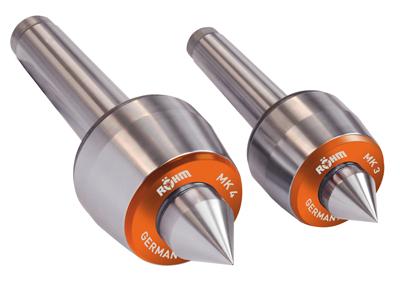
The new Orange Line from RÖHM, which covers drill chucks, live centers, lathe chucks and machine vises, comprises standardized product selections with several valuable advantages, including excellent price-performance ratios, high availability and fast repair services, according to the company.
The Orange Line's EXTRA RV-E keyless and PRIMA-L keyed drill chucks, available in different sizes and clamping capacities, accommodate a variety of applications, including hole drilling in steel and wood, percussion drilling and driving screws. Keyless clamping with the EXTRA RV-E involves a simple turn of its metal and plastic sleeve, while the PRIMA-L gets its clamping strength via DIN 6349 toothing. Both drill chucks have a through-hole feature that enables them to rotate clockwise and counterclockwise.
The Orange Line's new live centers have triple bearings for long life and high runout accuracy. Available in MT 3, MT 4 and MT 5 sizes, these centers are through hardened to withstand repeated regrinding. They also have slim housings to achieve lower interference shapes. Able to accommodate maximum workpiece weights of 661 (MT 3), 1,102 (MT 4) and 1,388 (MT 5) pounds, these centers withstand high clamping pressures and allow for high turning speeds without the need for separate lubrication.
In the manual lathe chucks category, the Orange Line offers the ZG geared scroll chuck, which features a high-value, vibration-dampening cast iron body and one-piece jaws. The ZG chucks are available in six standard sizes, each in 3-jaw and 4-jaw versions. These jaws move across the entire clamping range so that users can clamp workpieces of different diameters without having to change or shift the jaw.
Based on a modular design platform, the Orange Line's new RB machine vise is available as a mechanical (RB-M) or power intensified (RB-K) solution. The vise provides long guidance of its moveable jaw and accurately covers a wide clamping range with quick adjustments. All of the vise's wear parts, primarily the jaw guides, are hardened and ground to provide long-lasting durability. To ensure its accurate positioning, the vise's longitudinal grooves precisely match the t-slots of a machine tool table. Furthermore, the vise works with rotation plates to achieve angular settings for increased part machining flexibility.
Contact Details
Related Glossary Terms
- centers
centers
Cone-shaped pins that support a workpiece by one or two ends during machining. The centers fit into holes drilled in the workpiece ends. Centers that turn with the workpiece are called “live” centers; those that do not are called “dead” centers.
- chuck
chuck
Workholding device that affixes to a mill, lathe or drill-press spindle. It holds a tool or workpiece by one end, allowing it to be rotated. May also be fitted to the machine table to hold a workpiece. Two or more adjustable jaws actually hold the tool or part. May be actuated manually, pneumatically, hydraulically or electrically. See collet.
- lathe
lathe
Turning machine capable of sawing, milling, grinding, gear-cutting, drilling, reaming, boring, threading, facing, chamfering, grooving, knurling, spinning, parting, necking, taper-cutting, and cam- and eccentric-cutting, as well as step- and straight-turning. Comes in a variety of forms, ranging from manual to semiautomatic to fully automatic, with major types being engine lathes, turning and contouring lathes, turret lathes and numerical-control lathes. The engine lathe consists of a headstock and spindle, tailstock, bed, carriage (complete with apron) and cross slides. Features include gear- (speed) and feed-selector levers, toolpost, compound rest, lead screw and reversing lead screw, threading dial and rapid-traverse lever. Special lathe types include through-the-spindle, camshaft and crankshaft, brake drum and rotor, spinning and gun-barrel machines. Toolroom and bench lathes are used for precision work; the former for tool-and-die work and similar tasks, the latter for small workpieces (instruments, watches), normally without a power feed. Models are typically designated according to their “swing,” or the largest-diameter workpiece that can be rotated; bed length, or the distance between centers; and horsepower generated. See turning machine.
- modular design ( modular construction)
modular design ( modular construction)
Manufacturing of a product in subassemblies that permits fast and simple replacement of defective assemblies and tailoring of the product for different purposes. See interchangeable parts.
- through-hole
through-hole
Hole or cavity cut in a solid shape that connects with other holes or extends all the way through the workpiece.
- turning
turning
Workpiece is held in a chuck, mounted on a face plate or secured between centers and rotated while a cutting tool, normally a single-point tool, is fed into it along its periphery or across its end or face. Takes the form of straight turning (cutting along the periphery of the workpiece); taper turning (creating a taper); step turning (turning different-size diameters on the same work); chamfering (beveling an edge or shoulder); facing (cutting on an end); turning threads (usually external but can be internal); roughing (high-volume metal removal); and finishing (final light cuts). Performed on lathes, turning centers, chucking machines, automatic screw machines and similar machines.
